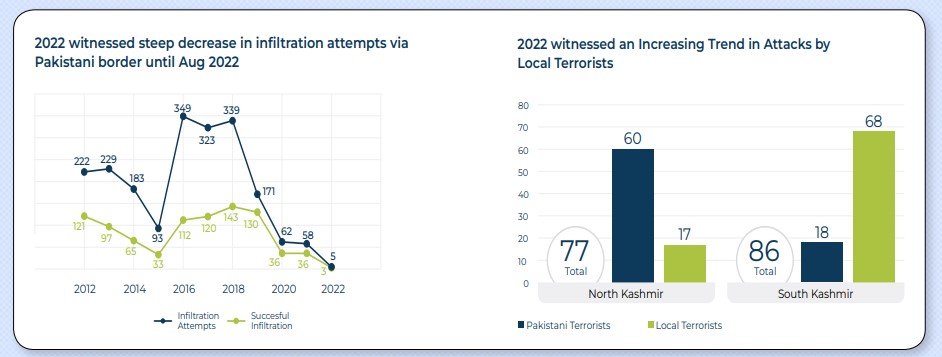
If 2022 was the year of India’s resurgence and resilience, 2023 can be termed as the year of economic fruition, internal security challenges and guarded optimism. Despite global headwinds, the prolonged war in Ukraine and increasing prospects of global recession, the India growth story will remain buoyant, and robust on the back of strong domestic factors. The World Bank opines that “while the deteriorating external environment will weigh on India’s growth prospects, the economy is relatively well positioned to weather global spillovers compared to most other emerging markets.”The year ahead will continue to be determined and shaped by geopolitical events. Their impact will cast a shadow on energy and food security, while also posing a risk of trade wars/barriers which India will have to navigate adroitly. Events like the price cap on Russian oil, and continued sanctions by the Western bloc, will create stress in our relations with some friendly countries. India as the newly elected President of G20, will need to be more objective and assertive in trying to solve the Ukraine imbroglio. Further deterioration of relations between NATO and Russia poses a strategic security dilemma for India.
The political uncertainty and resultant instability in Pakistan is a matter of concern for India. The forthcoming elections in Pakistan will manifest in a hardening of anti-India stance and rhetoric by most political parties. The recent undiplomatic utterance against PM Modi by the Finance Minister of Pakistan has exacerbated the situation further, and any chances of talks on easing of relations between the two has suffered a major setback. With Pakistan battling internal insurgencies, and increasing problems on its Eastern borders, any adventurism on our borders is unlikely. A reasonably stable LOC and secure borders with Pakistan for 2023 can be thus be forecast.

While events with China remained on low key for most of 2022, the year-end skirmish near Tawang demonstrated the fragility and volatility of the LAC with China.
While the Indian Army stood its ground and deterred Chinese designs firmly, the political fallout of the incident would increase the existing trust deficit between the countries, and also seriously undermine political options for a quick resolution of the boundary issues. The increased hostility would play out in the Asia-Pacific region, and push India further into taking a harder stance in QUAD, and result in increased militarization of its maritime interests in the Indian Ocean region. Relations with China will continue to be strained but any large scale hostilities are unlikely. Notwithstanding the security concerns, trade with China will continue to grow, albeit to China’s advantage.
Internally, the acrimonious electioneering towards the end of 2022 showed the increased polarisation and hardening of ideological stance by the ruling party, and the strident, but fractured opposition. This trend will not only continue in 2023, but is likely to deteriorate further with many high decibel elections due in the year. A degree of unrest and violence connected to political events cannot be ruled out. While the traditional internal security challenges like Maoism, and trouble in J&K are on the wane, societal unrest, strikes and large scale protests due to unemployment, reservations, and political affiliations are likely. The Maharashtra-Karnataka border issue has the potential of escalating as it has major political ramifications. The election of Prachanda as PM of Nepal is also an event of geo-political event of significance for India, and would need deft handling as some border tensions with Nepal could spiral out of control.
Overall, 2023 could see a possible V-shaped economic recovery on all fronts despite various headwinds. The external security scenario, though challenging, will remain mostly stable. Internal tensions and strife due to high intensity elections is most likely and would need to be monitored. Climate change, sustainability and cyber threats will also pose challenges for business in 2023. In summation, 2023 will be the year of the coming of age for India both economically, as also on the geopolitical front, with it assuming presidency of the G20 and its attendant responsibilities.
For India, 2022 began with the country seeking to refocus attention on multiple developmental fronts after waves of the COVID-19 pandemic subsided. Following a rollback of pandemic restrictions in late 2021 to enable economic recovery and a return to normalcy, the emergence of the Omicron variant and its eventual detection in India prompted another wave of lockdowns and restrictions across most parts of the country. However, the robust vaccine administration and lessons learnt from the second wave meant that the third wave was relatively benign, and several state governments realized the need to lift all restrictions in a gradual manner; and reorient lifestyles and business operations to coexist with the new realities brought by the pandemic.
An outbreak of infections in neighbouring China and the emergence of a sub-lineage of the Omicron variant have prompted fresh fears of a fourth wave. The emerging new strains of the pandemic have already triggered testing, surveillance and masking protocols; but the disaster management capability built up over the last couple of years is likely to result in a more resilient posture for India in 2023. Notwithstanding the latest spike, businesses, governments, and citizens alike have learnt to live along with the virus, and would be able to cope with any eventual outbreaks in the coming year.
On the geopolitical front, relations with China and Pakistan remained adversarial, but relatively peaceful up until December, when Indian and Chinese troops engaged in unarmed clashes at Tawang sector in Arunachal Pradesh when People’s Liberation Army of China (PLA) soldiers tried altering the status quo. Several injuries were reported on both sides, and the clashes threatened to unravel and reverse any gains made in September when both troops unanimously agreed to disengage from the Gogra Hot Springs region. Ties with Pakistan witnessed a relative thawing in 2022 after the escalations in 2019 and 2020, with the Pakistani government even considering requesting aid from India following the widespread floods in the country.
However, it remains impossible to delink the issue of Kashmir from India-Pakistan dialogue, and with the Indian government remaining steadfast on its agenda of expediting the region’s greater integration into the mainland, it would be imprudent to make any assumptions or predictions about a paradigmatic change in bilateral relations.

Extremism in Jammu & Kashmir continued in 2022, and an evident trend of targeted attacks on non-local civilians was witnessed, triggering protests and fresh apprehensions from the Kashmiri Pandit community. With new militant groups emerging in the Valley, including United Liberation Front of Kashmir (ULFK), The Resistance Force (TRF), Kashmir Tigers, and People’s Anti-Fascist Force (PAFF), a new pattern of domestic terrorism could emerge and consolidate in 2023, which may pose newer challenges to anti-terrorism and other security forces. Left-Wing Extremism in parts of Central and Eastern India; and insurgency in the North East states displayed a continuing declining trend with increased surrenders and fewer encounters; resulting in an overall improvement in the lawand-order situation.
The coming year will also be critical on the political front with as many as ten states heading into their Assembly elections in the run-up to General Elections in 2024. There is likely to be charged political rhetoric in the state of Karnataka, which witnessed a surge of communal dissension in 2022. There may be some further election related saber-rattling on the border dispute with Maharashtra over Belagavi, which became a flashpoint in December 2022 and witnessed sporadic clashes and occasional violence. The states of Madhya Pradesh, Rajasthan, and Telangana are also scheduled to hold elections, with opposition parties such as the Indian National Congress (INC), Aam Aadmi Party (AAP), Telangana Rashtra Samithi (TRS, now rebranded as Bharath Rashtra Samithi) etc., looking to build on their electoral gains in 2022 and consolidate momentum. Several states in India’s NorthEast including Tripura, Meghalaya, Mizoram, and Nagaland will also undergo elections, and pre-poll violence and interference by separatist groups may cause disruptions.

Flashpoints in inter-state disputes flared up towards the end of 2022, with violence reported at the Assam and Meghalaya border that resulted in six deaths in November. In December, the Supreme Court gave the Centre three months to constitute an Inter-State River Water Disputes Tribunal to resolve the dispute between Tamil Nadu and Karnataka over constructions in Pennaiyar river. Water-sharing and riparian rights between the two states have always remained a sensitive subject and have the potential to escalate into agitation and violent protests.
On the economic front, India made a commendable recovery following the successive lockdowns of 2021, prompting the World Bank to revise its 2022-23 GDP forecast upward to 6.9 percent from 6.5 percent (in October 2022), considering a strong outturn in India in the second quarter (July-September) of the 2022-23 financial year. The Indian economy was remarkably resilient to strong global economic headwinds brought about the Russia-Ukraine crisis; and the remnant and lingering effects of the COVID-19 pandemic. India has opted for tech and manufacturing led growth, supported by Production Linked Incentive Schemes (PLIS) and digitization, nationalistic politics and decoupling from China. When juxtaposed with other emerging market economies, especially in South Asia, the Indian economy seems to be in a good position for sustained growth.
The coming year is also likely to refocus attention on India’s preparedness for extreme weather events, and its metro cities’ capability to keep pace with rapidly escalating and unpredictable climatic changes. The vastness of India’s geography makes it vulnerable to a host of natural hazards including earthquakes, floods, landslides, and cyclones, and gradually warming climate is likely to pose serious challenges to disaster mitigation plans. 2022 witnessed severe flooding in Assam and Meghalaya, while waterlogging and associated events such as landslides were witnessed all across the country, causing significant damage to property and claiming dozens of lives. As per the environmental think tank Centre for Science and Environment, in the initial 273 days of 2022, India witnessed 241 days of some or the other kind of natural hazard. The northern parts of the country also witnessed a heat wave of unprecedented proportions, resulting in steep energy demand and precipitating a secondpower crisis in the country in the span of just 6 months, prompting questions over India’s energy security amid geopolitical developments in Ukraine. Major flooding was also witnessed in Bengaluru in the month of September that severely affected road conditions, drainage, emergency response, power and water supply etc., that paralyzed business operations.
Further, businesses in India will have to contend with the difficult question of maintaining a balance between remote and in-person working. Many companies instituted a Return-to-Office rule in 2022 while still offering employees the option of working from home on some days of the week. With the peak period of pandemic related disruptions seemingly behind us, companies may look to institute pre-pandemic working models to accommodate the human requirement of a social infrastructure and to increase productivity. While remote working has enabled companies to secure talent catchment, move towards meeting ESG commitments, and prevent loss of work hours due to commuting, empirical evidence from surveys has suggested that productivity increases when there is greater physical engagement.
Technology Front
Finally, organizations will also have to contend with evolving cyber threats, especially heightened vulnerabilities associated with remote working environments and the rise in state sponsored attacks. Data provided to the Indian Parliament revealed that between June 2018 and March 2022, India’s banks recorded 248 successful data
breaches, of which 41 cases involved public sector banks, 205 were those of private sector banks, and two involved overseas banks. In November and December, this vulnerability was made evident after the Central Depository Services (India) Limited (CDSL) detected a malware in its systems, followed by a major ransomware attack on India’s top medical institution – the All-India Institute of Medical Sciences (AIIMS). The Indian Computer Emergency Response Team (CERT-IN) in its India Ransomware Report 2022 stated that there was a 51-percent increase in the number of ransomware attacks across multiple sectors including critical infrastructure. Therefore, malware, phishing, Distributed Denial of Service (DDoS) attacks, ransomware and malvertising attacks will remain critical concerns in 2023. The year 2023 is likely to pose novel challenges and evolved conventional risks; but these may also present opportunities for businesses to diversify, consolidate or innovate as the case may be. The subsequent sections of this document will analyze the risks of 2022 while also providing projections for 2023.
